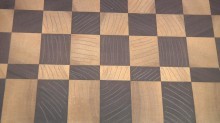Why Did My Cutting Board Split?
I don’t know if this ever happens to you, but sometimes my tools just get out of whack and start to sound funny. Take a listen and let me know if you have any advice.
Why Did My Cutting Board Split?
George Cook wrote in and asked,
My first attempt at an end grain cutting board was OK but I need to fine tune. My biggest problem is that two weeks after I finished I have some large cracking. The wood was dry and the kitchen environment isn’t all that different. I used ironwood and oak. The board is about 1 1/4″ thick sealed with mineral oil. Any clues as to how to prevent this?
There are two things working against us with end grain cutting boards. The first is using multiple wood species. Not every cutting board is made from multiple species but most of them are as they tend to look cooler that way. But each species has its own wood movement properties when exposed to moisture. So by mixing multiple species, each of the little squares is moving at a slightly different rate which leads to internal stress in the board.
 The second issue has to do with grain direction. Many end grain boards end up with the grain going every which way. But as we know, wood moves most across the grain so if some are the pieces are running one way and the others are running perpendicular to that, we can once again end up with lots of internal stress.
The second issue has to do with grain direction. Many end grain boards end up with the grain going every which way. But as we know, wood moves most across the grain so if some are the pieces are running one way and the others are running perpendicular to that, we can once again end up with lots of internal stress.
So does this mean all end grain cutting boards are doomed to fail? Not at all. In fact most of them will do just fine as long as they are seasoned well and aren’t exposed to large amounts of moisture repeatedly. But understanding these two causes of internal stress can help you stack the cards in your favor for a successful long-lasting cutting board.
Want to make the cutting board I showed in this video? Check this out!
The post Why Did My Cutting Board Split? appeared first on The Wood Whisperer.



